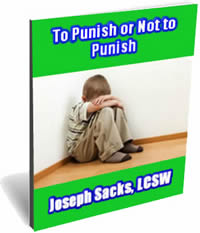How to set limits for your child
/By Joseph Sacks, LCSW
Are you frustrated by your child's breaking rules? Is there a constant power struggle between you and him or her? Do you feel powerless and that things sometimes get out of control? Does she just not seem to listen?
Learning how to set limits for your child can be extremely challenging but keeping a few pointers in mind can make things go much more smoothly.
Please bear in mind that the principles expressed here represent an ideal parenting goal, and one should not expect to achieve these ideals perfectly. Please have patience with yourself and try to implement them little by little as every little bit we do will have tremendous benefits for the emotional health of our child.
How to set limits for your child: finding a balance
The name of the game in setting limits is balance. It is helpful to learn the right amount that your child not only needs, but that he can handle. If you set too few limits your child will be unsafe, but on the other hand, setting too many limits can also be dangerous, as the child will feel restricted, resentful, and will rebel. His sense of autonomy will be damaged. Too many limits also prevents the development of responsibility, initiative and decision-making. Children need to flex their muscles, and need room to grow and to test the waters. Giving children as much freedom as possible empowers them. The trick is to find the volume of limits that the child can handle and still feel comfortable, and to then spend those limits wisely. We can only enforce so many limits, therefore we need to save those opportunities for the more important items such as not running into the street or not doing something dangerous. We should try to overlook minor infractions and avoid setting unnecessary limits on our children. This gives us the power to enforce limits with regard to more important items. You'd be amazed at how cutting out a few limits on minor items will drastically increase his compliance with those fewer remaining limits. For example, it may often be acceptable behavior for a five-year-old to stand on a chair when harm is not likely to come from it. This is ordinarily something a five year old likes to do. If however we consistently set limits on such behavior, the child will feel restricted and be less likely to listen to the next limit. In other words, not limiting his standing on the chair gives us the power to enforce a limit later, such as, let's say, not throwing a toy at a window or at the TV. We should allow a child to do as much as may be safe and appropriate. Placing too many limits on his activity may be a result of overestimating the danger or the impropriety, and may result in an unhappy child who is more likely to misbehave later. Instead the goal should be to find a way to compromise and safely allow activities.
Check out my post: How to get my child to cooperate.
Accept feelings.
A great way to promote your child's acceptance of a limit is to accept and reflect the child's feelings before the limit is set. Say, “I see you're really happy playing with that ball. You're having a good time, but I need to ask you to play outside.” The child gets pleasure when we recognize his feelings and this pleasure gives him the fortitude to comply with the limit. In addition we need to anticipate that the child will be unhappy with the limit and reflect and accept that feeling as well. Say, “Oh, you're feeling disappointed because I can't let you play ball now. I know you were really having a good time, but now you have to go outside.” Recognizing and validating the disappointment makes it easier for them to handle it. What's really important is the way you say ‘no’. Limits must be set in a way that deliberately calculates how to avoid creating resentment and how to preserve the child’s self-respect. Limits must be set gently and politely.
For more information on validating your child's feelings, click here.
When you have to say ‘no’ try whenever possible to provide a substitute activity, “You can’t play on the rocks but you can go on the swings.” Express to the child how much you wish you could say ‘yes’.
Another great technique for setting limits, developed by educator Haim Ginott, is to give your child his wish in a fantasy. Let's say you have to limit his ice cream, as he, of course, can’t have an unlimited amount. Say, “I wish I could buy you the biggest most delicious ice cream cone dripping with chocolate. I wish I could buy you five ice cream cones . . . I would do it right now.” This makes it easier for the child to accept one scoop only. Say, “That would be really great if you could go rock climbing up there. You could climb all the way to the top and back down ten times.” Giving a child his wishes in a fantasy shows we understand how he feels, we respect his desires, we appreciate his struggle, and makes him feel loved. It gives him the strength to tolerate the limit. See this great post: How to tell my child I can't buy him what he wants.
Limits need to be expressed in very brief language. Avoid long-winded explanation and arguments. Use expressions like, “That truck is not for throwing and, “The wall is not for drawing on.”
Express your feelings, too.
When the limit is broken do not yell, criticize or punish. Instead, express your feelings about the event. “It makes me very angry when you throw things.” “It upsets me to see crumbs on the couch.” Express your values, “In our house we put things away when we’re done with them.” Again Haim Ginott wisely says, “Hurl values, not insults- hurl feelings, not criticism.”
The most important element in child rearing is the crucial child-parent relationship. We must strengthen this relationship at all costs. This is done by being a source of pleasure to our children. Yes, limits need to be set for safety, but we need to keep them to a minimum to avoid being a source of frustrating restriction to the child which damages the parent-child relationship. Try to always be a source of pleasure to your child. By making him happy regularly, you will see there will be less of a need to set limits!
To find out a great trick to get kids to listen, click here.
For more helpful parenting advice, feel free to peruse the rest of my interesting blog, the specialties on my website, or download one of my informative free reports.
If you are facing challenges regarding how to set limits for your child, and would like guidance or treatment from a child psychotherapist in lower Manhattan,
you may call me at 646-681-1707 for a free 15-minute consultation. I look forward to speaking with you!






























